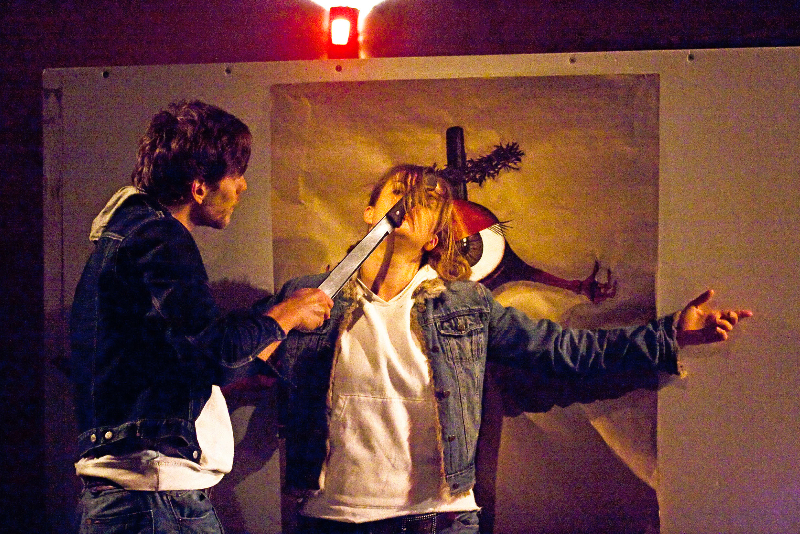
CAFÉ DE LA GARE French Photography in a Single Collection of the Château d’Eau Gallery

This exhibition brings together several generations of French photographers, ranging from great humanists to the young modern artists. On all accounts, this is an uncommon view of the Man, of the others, the view which is animating the images in the pictures. The present selection of the works lets us identify three important periods:
1960´s – 1980´s The period bears the mark of poetic realism, so characteristic for the French school of reportage. Robert Doisneau, Willy Ronis, Edouard Boubat, Izis and others have a rapt look at the society and prefer poetic and lyrical view of the world while putting the Man in the spotlight. The period is also important for the Magnum Agency /1/ and for the impact of Henri Cartier-Bresson: framing accuracy, selection of the ´decisive moment´ /2/, or for the respect for natural light. This all can now be seen in the pictures by Marc Riboud a Guy Le Querrec.
1980´s – 1990´s Triggered by Cahiers de la photographie /3/ (Books of Photography) and by the release of La chambre claire (Light Chamber) by Roland Barthes, the period drifts away such photography action which leads to more autobiographic approaches, to experiments placing the photographer into the centre of his shots. The subject wide-spoken is creative photography (Gladys). This photography fosters a less demonstrative view (Luc Chery), a rather unrestrained view of the world (Bernard Plossu, Stéphane C.), a view asking more questions (Raymond Depardon), a view more literary and poetic in nature (Denis Roche, Sarah Moon).
Since 1990´s we have been witnessing a radical change showing a transition to colour photography and to large-size shots. Photography steps into the field of contemporary art. These art designers “use” photography to explore urban landscape and to confront void or transitive space (Olivier Metzger, Eric Aupol). Those following the traditional land art conduct a dialogue with the reality in place in order to modify the perception of the reality (Laurent Millet). Others, on the other hand, break the borders between fiction and reality when using technical tricks in order to tear off the mask of some false certainties (Corinne Mercadier).
Nevertheless, the greatest development has been apparently observed in the portrait making. The changeover took several years to begin with a psychological approach driven by empathy for the person photographed, which, actually, abided by the tradition of true portrait (Gisele Freund, Richard Dumas); then it went through an experimentation phase (Jean-François Bauret – nudes) to be later followed by a modern-time production aspiring to keep a fair distance and objectivity, and to drain all psychology off photography in order to have more sociological, even more political approach to photography where the Man is judged in terms of his affiliation to a certain social group (Dominique Delpoux, Charles Fréger). Based on the peculiarities of its own history, photography becomes an image among other images in order to deliver a new understanding of the world.
LE CHATEAU D’EAU, TOULOUSE
This gallery was established in 1974 by Jean Dieuzaide. It is the oldest public gallery in France exclusively devoted to photography. The Château d’Eau Collection, which is made up of the pieces bought from the exhibiting authors, possesses now almost 5,000 photographs. Since its founding Château d’Eau has held more than 400 exhibitions. Focused on presenting all aspects of photography, the gallery shows photos of young talents as well as of the authors of distinguished names making the history of photography.
Explanatory Notes:
1. Photography agency founded in 1947 by Robert Capa, Henri Cartier-Bresson, George Rodger and David Seymour.
2. “The decisive moment” refers to a concept of photography, which Cartier-Bresson created and which centres on the moment the photographer catches – the moment of the story.
3. Les Cahiers de la photographie is a magazine created by Denis Roche, Bernard Plossu, Gille Mora, Claude Nori.
4. The main work of reflections on the photographic image written by Roland Barthes, the French philosopher exploring symbols.
Jean-Marc Lacabe: The French photography is centred on the Man. “The exhibition is special for its summary of French photography of several decades. At the heart of the French fine art photography is a human being. Fine art photographers in France mainly capture scenes of life. The exhibition opens up with the photographs from the 1930´s and proceeds to the post-war time pictures. I call these two periods a humanistic period of fine art photography in France. The exhibition also displays photographs from the 1980´s and 1990´s which may be denoted as pictures of rather intimate character. These artists are not reluctant to take pictures of their families on holidays to turn them into fine art photography,“ mentioned Jean-Marc Lacabe, the Director of the Château d’Eau Gallery in Toulouse in regard of the Café de la gare exhibition.
Text: Zuzana Lehotská
